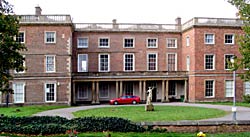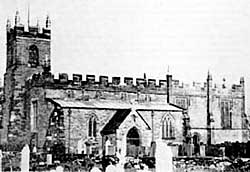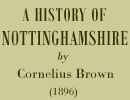< Previous | Contents | Next >
Clifton and Wilford

The east front of Clifton Hall (A Nicholson, 2004).
To the busy residents of Nottingham the charms of Clifton Grove are pleasingly familiar. Nothing can be more delightful on a hot day than to bid a brief adieu to the whirl of the county town, and to spend a few hours of peaceful solitude among stately trees by the side of the glistening waters of the Trent. Kirke White’s poetic description of the scene is worth perusal, not only for the chaste and simple language depicting the beauties of the Grove, but for its vivid narrative of the Fair Maid of Clifton, and her strange career.
The Manor of Clifton is one of considerable antiquity and significance. Thoroton says it can be traced as far back as the days of Edward the Confessor, and belonged to the famous Countess Godiva. In the time of William the Conqueror it came into the possession of William Peverel, but appears to have reverted to the Crown in Henry II.’s reign. The Cliftons, who took their surname from the village, were then coming into note, although they did not obtain the lordship of their native place till the days of Henry III., when Sir Gervase de Clifton purchased the manor of Gerard de Rhodes. In the reign of Edward I.
Sir Gervase was High Sheriff of Notts and Derbyshire, and had granted to him by Robert de Tibtot, Constable of Nottingham Castle, a demise of the castle and precincts for a term of years, and hence probably arose the title of ‘Guardianus Castelli de Nottingham,’ assigned to his family in the old ‘Visitations.’ A branch of the Cliftons kept the surname of Wilford, and one, Gervase de Wilford, was Chief Baron of the Exchequer, 24th Edward III. Another member of the family, who also had the favourite name of Gervase, married Maud, niece of Lord Cromwell, and became possessed of lands in Kent. He was an active warrior, both on land and sea, against the foreign enemies of the nation. At home he adhered closely to the Lancastrian cause, and even after the fatal field of Towton he did not desert the fallen house. He was accused of conspiring to release King Henry from the Tower, and flying with other companions in arms for safety, took refuge in the abbey church at Tewkesbury. Here he was tracked by King Edward and his followers, who would have rushed upon them with the sword had not a priest intervened to remind them of the sanctity of the place. A respite awaited them for two days, and they were then brought before the Duke of Gloucester (afterwards Richard III.), who condemned them to death, and Sir Gervase and his companions were beheaded in Tewkesbury market-place.

St Mary, Clifton.
But while one Clifton suffered for his loyalty, another became a member of Edward’s Court, and at the coronation of Richard III. was created a Knight of the Bath. Another Sir Gervase held positions of influence in the reigns of Henry VIII., Edward VI., Mary, and Elizabeth, and his bearing was so courtly in this age of chivalry, that he was styled ‘Gentle Sir Gervase.’ The representative of the family in the time of James I. was created a Baronet by that monarch, and in the reign of Charles I. he was a Commissioner for the King at Oxford and Newark. He married no less than seven wives, and lived to a great age.
All the successors to the title have been closely associated with Nottingham, and the last Baronet was one of the most popular men who ever represented the borough in Parliament. The church contains many memorials of the family, which played an important part in the history of the country for a lengthy period.
Indelibly associated with Clifton and the Clifton family is Wilford, another picturesque Trentside village. The first Rector of Wilford of whom there is any record is John de Clifton, who was nominated in 1297 by Sir Gervase, the patron, and in succeeding generations many of the Cliftons held the same honourable office. One of them, Gamaliel Clifton, rose to be Dean of Hereford, and having considerable repute as a canonist, was one upon whom the duty was cast of advising Henry VIII. how to rid himself of Catherine of Aragon and Anne of Cleves.

St Wilfrid, Wilford.
A tomb in the churchyard brings to mind the career of Captain Deane, who was the son of a Nottingham gentleman, but first fancied the trade of a butcher. His life extended into the reigns of no less than seven monarchs, from Charles II. to George III. Forsaking the cleaver, he took to deer-stealing, fled the country, became a seaman, fought at Gibraltar, was raised to the position of a captain in the navy, fitted out a ship to trade with North America, was wrecked, and after twenty-six days’ exposure on a rock in a state of destitution, was picked up by a passing vessel and returned to England. Deane’s brother upbraided him for the loss of their barque, and in a quarrel between them ruptured a bloodvessel and died. The seaman became Consul at some of the Continental ports, and retired to Wilford in 1738, where he died.
On the south wall of the chancel there is a fine marble medallion bearing an excellent portrait of Henry Kirke White, the poet, and one of the windows is filled with stained glass ‘In Memoriam H. K. W.,’ supplied by public subscription. The poet spent many pleasant days in 1804, and succeeding years, at Wilford, and the groves of Clifton, with the silvery Trent, were just the scenes to draw forth his best efforts at depicting the loveliness of nature in verse.
After ‘a sharp fit of sickness,’ consequent upon a bitter disappointment and months of intense study, he recovered sufficiently to resume his favourite walks round Wilford, and sitting in the churchyard, with the Trent flowing swiftly at his feet, and the hot sun vainly endeavouring to struggle through the foliage of the trees around him, he wrote the sorrowful but beautiful lines:
‘Here would I wish to sleep; this is the spot
Which I have long marked out to lay my bones in.
Tired out and wearied with the riotous world,
Beneath this yew I would be sepultured.
It is a lovely spot! the solitary sun
From his meridian height endeavours vainly
To pierce the shadowy foliage, while the zephyr
Comes wafting gently o’er the rippling Trent
And’ plays about my wan cheek. ‘Tis a nook
Most pleasant. Such a one perchance did Gray
Frequent, as with vagrant muse he wantoned;
And I will set me down to meditate,
For I am wearied with my summer’s walk.
And here I may rejoice in silent ease,
And then, perchance, when life’s sad journey’s o’er,
My harassed soul in this same spot may find
The haven of its rest beneath this sod
Perchance may sleep it sweetly, sound as death.’
Kirke White succumbed at an early age and was buried at Cambridge; but a cottage where he lodged during the days of his musings on the banks of the river is still pointed out at Wilford to interested visitors.
